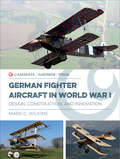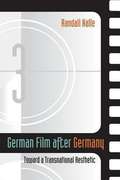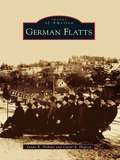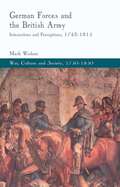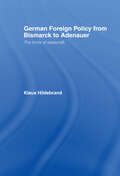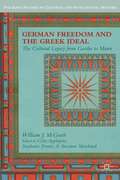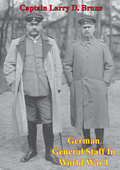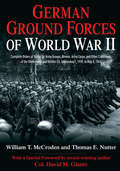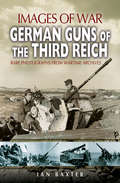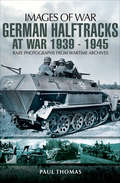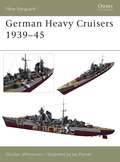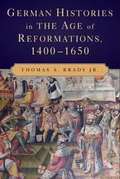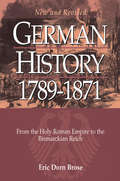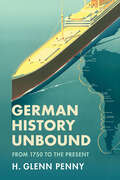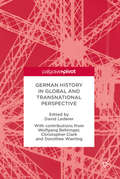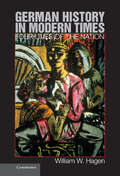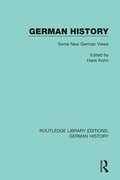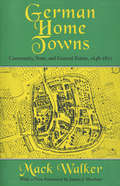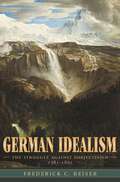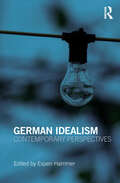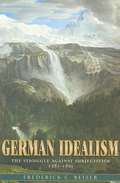- Table View
- List View
German Fighter Aircraft in World War I: Design, Construction and Innovation (Casemate Illustrated Special #Ciss0002)
by Mark C. WilkinsThis fully illustrated volume explores German military aviation during WWI through archival photographs and authentically detailed replicas. Fighter aircraft were developed during World War I at an unprecedented rate, as nascent air forces sought to achieve and maintain air supremacy. German manufacturers innovated at top speed, while constantly scrutinizing the development of new enemy aircraft. The Germans also utilized the concept of modular engineering, which allowed them to disassembled or reassembled their aircraft quickly in the field. The pinnacle of their aeronautical innovations was the iconic Fokker D VII—the only aircraft specifically mentioned in the Treaty of Versailles, which forbade Germany from building it after the war. German Fighter Aircraft in World War I explores how German fighter aircraft were developed during the war, the advancements and trials that made the Fokker D VII possible, and the different makes and types of aircraft. Using unpublished images including photographs of surviving aircraft, archive images, and models and replicas, this volume shows details of aircraft that were kept top secret during the war. Extensively illustrated with 140 photos and ten color profiles, this is will be essential reading for all WWI aviation enthusiasts and modelers.
German Film after Germany: Toward a Transnational Aesthetic
by Randall HalleWhat is the work of film in the age of transnational production? To answer that question, Randall Halle focuses on the film industry of Germany, one of Europe's largest film markets and one of the world's largest film-producing nations. In the 1990s Germany experienced an extreme transition from a state-subsidized mode of film production that was free of anxious concerns about profit and audience entertainment to a mode dominated by private interest and big capital. At the same time, the European Union began actively drawing together the national markets of Germany and other European nations, sublating their individual significances into a synergistic whole. This book studies these changes broadly, but also focuses on the transformations in their particular national context. It balances film politics and film aesthetics, tracing transformations in financing along with analyses of particular films to describe the effects on the film object itself. Halle concludes that we witness currently the emergence of a new transnational aesthetic, a fundamental shift in cultural production with ramifications for communal identifications, state cohesion, and national economies.
German Flatts
by Caryl A. Hopson Susan R. PerkinsGerman Flatts was established on March 7, 1788, and is comprised of two unique villages. The village of Mohawk was incorporated in 1844, and Ilion soon followed in 1852. With their proximity to the Erie Canal, these villages saw their share of business and industry and flourished as communities. Mohawk was home to a number of famous people, including a treasurer of the United States, a General Motors industrialist, one of the fated space shuttle Challenger crew members, and the two Keno brothers who made antiques a popular obsession on the television program Antiques Roadshow. Ilion is the birthplace of the Remington Arms Company, one of Herkimer County's oldest industries that still exists today and is known around the world. German Flatts provides an interesting snapshot of the daily life and important events in this community's fascinating history.
German Forces and the British Army
by Mark WishonThis book examines the partnerships between Britain's famed redcoats and the foreign corps that were a consistent and valuable part of Britain's military endeavors in the eighteenth century. While most histories have portrayed these associations as fraught with discord, a study of eyewitness accounts tells a different story.
German Foreign Policy: The Limits of Statecraft
by Klaus HilderbrandFirst Published in 1989. Routledge is an imprint of Taylor & Francis, an informa company.
German Freedom And The Greek Ideal
by William J. McgrathThis book traces this German idea of freedom from the late Enlightenment through the early twentieth century. McGrath shows how German intellectual and artists invoked the ancient Greeks in order to inspire Germans to cultural renewal and to enrich their understanding of freedom as something deeper and more urgent that political life could offer.
German General Staff In World War I
by Captain Larry D. BrunsThis study reviews the problems of the German General Staff during the First World War in an attempt to highlight successes and understand failures. The investigation focuses on the traditional staff functions of intelligence, operations, logistics and command, control and communications. To obtain a comparison, two epic battles on the Western Front were used, the Battle of the Marne in 1914 and the first spring offensive, Michael, in 1918. This study revealed that the German General Staff did an excellent job in staff thought, planning and execution. However, in the area of command, control and communications they were not as capable. The defeat at the Marne and the eventual failure of Michael were the result of command, control and communications problems which prevented the German General Staff from placing needed forces at a decisive point and time to obtain a strategic victory. These command, control and communications problems provide a constant underlying theme for the defeat of German forces in the First World War. The United States Army faces many of the same command, control, and communications problems faced by the German General Staff almost seventy years ago. This study highlights the German errors so that United States Army will not make the same mistakes.
German Ground Forces of World War II: Complete Orders of Battle for Army Groups, Armies, Army Corps, and Other Commands of the Wehrmacht and Waffen SS, September 1, 1939, to May 8, 1945
by William T. McCroden Thomas E. NutterGerman Ground Forces of World War II offers the first comprehensive order of battle for German ground troops throughout the Second World War, from the invasion of Poland on September 1, 1939, to the destruction of the last remnants of Germany’s Wehrmacht and Waffen SS in Berlin in 1945. Unlike similar works, these orders of battle are dynamic, and so account for the continuously changing character of Germany’s ground forces at war. This massive new reference work by McCroden and Nutter, broken up in sections including Theater Commands, Army Groups, Armies, and Corps Commands, presents a detailed analysis of each corresponding order of battle for every German field formation above division. Additional new ground is broken by also describing the orders of battle of the myriad German and Axis satellite formations assigned to security commands throughout occupied Europe and the combat zones, as well as those attached to fortress commands and to the commanders of German occupation forces in Eastern and Western Europe. An accompanying narrative describes the career of each field formation and includes the background and experience of many of their most famous commanding officers. For the first time, readers can follow the career of every German division, corps, army, and army group as the German armed forces shifted units to and from theaters of war, from the period of triumphant successes to the years of grinding defensive warfare and eventual defeat.
German Guns of the Third Reich: Rare Photographs from Wartime Archives (Images of War)
by Ian Baxter"German Guns of the Third Reich is an illustrated record of German light and heavy artillery, heavy mortars, anti-tank and anti-aircraft guns at war. Using previously unpublished photographs, many of which have come from the albums of individuals who took part in the war, it presents a unique visual account of the various German guns that were deployed for action between 1939 and 1945.The book analyses the development of the German gun at war and shows how it became of decisive importance for the preparation and the successful conduct of atta and defense. It describes how German forces carefully built up their assault forces utilizing all available guns and making into an effective killing machine. It shows how various Panzerjger and Panzergrenadier units fought on the battlefield using a host of antitank guns with lethal effect. Throughout the book it depicts life as a gunner, how the guns were deployed for action, and illustrates the various modes of transport that were used to move the guns from one battle front to another. Each chapter details the various guns that went into production and eventually saw action on the battlefield. "
German Halftracks at War, 1939–1945 (Images of War)
by Paul ThomasThe author of the bestselling Panzer IV at War delivers a highly illustrated look at &“a key element in the German Blitzkrieg&” during the Second World War (HistoryOfWar.org). In the aftermath of the Great War, which saw the introduction of the tank, the more far sighted military leaders realized that the future of warfare hinged on a balance of mobility, firepower and protection. Tanks would need to be accompanied into battle by supporting arms, specifically infantry, artillery and engineers. An all fully-tracked field army was thought to be too expensive, so the semi-tracked support vehicle (commonly called a halftrack) was born. The halftrack concept was embraced by France, the US and most notably Germany. The Germans commissioned numerous types of half-tracked tractors, which were classified by the weight of their towed load. These vehicles were designated Sonderkraffarzeug (special motorized vehicle), abbreviated as Sd.Kfz. These front-wheel steering vehicles with tracked drive transformed the fighting quality of the armored divisions. They carried the infantry alongside the advancing panzers and brought guns and pontoon-bridge sections. The halftrack also became the preferred reconnaissance vehicle. This latest addition to the highly successful and collectable Images of War series has a superb collection of rare images, supported by detailed captions and text, of the many Sd.Kfz variants in diverse theatres of war. It is worth reflecting that, without half-tracks, there could have been no Blitzkrieg.
German Heavy Cruisers 1939-45
by Ian Palmer Gordon WilliamsonThe development of this excellent and successful class of warship only became possible after the Anglo-German naval agreement of 1935 eased restrictions on the types of ship Germany could build; even then only five of the class were permitted: the Admiral Hipper, the Blücher, the Prinz Eugen, the Seydlitz and the Lützow. These Cruisers were designed for Atlantic operations and had eight 8 inch guns, 12 10.5 cm heavy anti-aircraft guns and 17 smaller calibre anti aircraft guns as well as twelve torpedo tubes and their own compliment of up to six aircraft. This title covers the design, development and operational history of the Heavy Cruisers of the Admiral Hipper class.
German Histories in the Age of Reformations, 1400–1650
by Thomas A. Brady Jr.This book studies the connections between the political reform of the Holy Roman Empire and the German lands around 1500 and the sixteenth-century religious reformations, both Protestant and Catholic. It argues that the character of the political changes (dispersed sovereignty, local autonomy) prevented both a general reformation of the Church before 1520 and a national reformation thereafter. The resulting settlement maintained the public peace through politically structured religious communities (confessions), thereby avoiding further religious strife and fixing the confessions into the Empire's constitution. The Germans' emergence into the modern era as a people having two national religions was the reformation's principal legacy to modern Germany.
German History 1789-1871
by Eric Dorn BroseDuring recent years, there has been a noticeable increase in interest in the nineteenth century, resulting in many fine monographs. However, these studies often gravitate toward Prussia or treat Germany's southern and northern regions as separate entities or else are thematically compartmentalized. This book overcomes these divisions, offering a wide-ranging account of this revolutionary century and skillfully combining narrative with analysis. Its lively style makes it very accessible and ideal for all students of nineteenth-century Germany.
German History Unbound: From 1750 to the Present
by H. Glenn PennyWhat is German history? Where did it take place? And what role did Germans living outside of Central Europe play in it? This polycentric history offers a new vision: It uses communities of Germans, from Austria to Chile to Russia, to rethink our narratives of modern German history. Focusing on the great plurality of Germans, and their interconnections around the world, it pointedly de-centers the nation-state while arguing that resisting its dominance in our historical narratives has high intellectual and political stakes. For within an unbound German history there are characteristics, clues, models, and precedents that can do much to undermine the return of violent, exclusionary nationalism. To that end, this book calls for a greater integration of mobilities, migration flows, different ways of belonging, and transcultural places into our narratives of Germans' histories. Ultimately, it reveals how embracing a range of narratives can help us to better understand people's actions, intentions, and motivations in particular historical moments.
German History in Global and Transnational Perspective
by David LedererThis is a collection of essays from three of the world’s pre-eminent historians of Germany, which consider German history in global and transnational contexts. It is well known that transnationalism has exploded in the last decade or so as a new academic subfield of international and global history. What the transnationalism literature often ignores or downplays, however, is the role of the nation-state in making the transnational possible in the first place, as noted in its very etymological origins. This volume traces this dynamic from a different vantage-point, namely the relationship between German history and transnationalism. Each essay applies a transnational framework in fresh and original ways in order to illuminate different facets of the connections between Germany and the wider world in the modern period. Together they will encourage the rethinking of assumptions about key moments and developments in the history of modern Germany, and foster reflection on the evolving nature of German history as a subject studied in the twenty-first century.
German History in Modern Times
by William W. HagenThis history of German-speaking central Europe offers a very wide perspective, emphasizing a succession of many-layered communal identities. It highlights the interplay of individual, society, culture, and political power, contrasting German with western patterns. Rather than treating "the Germans" as a collective whole whose national history amounts to a cumulative biography, the book presents the pre-modern era of the Holy Roman Empire; the nineteenth century; the 1914-1945 era of war, dictatorship, and genocide; and the Cold War and post-Cold War eras since 1945 as successive worlds of German life, thought, and mentality. The book sets forth the differences between them, even as it traces paths leading from one to the other. This book's "Germany" is polycentric and multicultural, including the multi-national Austrian Habsburg Empire and the German Jews. Its approach to National Socialism offers a conceptually new understanding of the Holocaust. The book's numerous illustrations reveal German self-presentations and styles of life, which often contrast with western ideas of Germany.
German History: Some New German Views (Routledge Library Editions: German History #28)
by Hans KohnOriginally published in 1954, this book presents the view of nine liberal German historians in reconsideration of the dominant concepts of German political and cultural history in the immediate post-war years. They review critically not only the rise and rule of National Socialism, but also the strength of authoritarianism and militarism, the weakness of democracy and liberal attitudes in 19th Century Germany. The essays were published in German periodicals and pamphlets between 1945 and 1952 and collected in this volume (and translated into English) they represent a survey of one of the most important intellectual movements of reconsideration and of political and moral readjustment after World War II.
German Home Towns: Community, State, and General Estate, 1648–1871
by Mack Walker James J. SheehanGerman Home Towns is a social biography of the hometown Bürger from the end of the seventeenth to the beginning of the twentieth centuries. After his opening chapters on the political, social, and economic basis of town life, Mack Walker traces a painful process of decline that, while occasionally slowed or diverted, leads inexorably toward death and, in the twentieth century, transfiguration. Along the way, he addresses such topics as local government, corporate economies, and communal society. Equally important, he illuminates familiar aspects of German history in compelling ways, including the workings of the Holy Roman Empire, the Napoleonic reforms, and the revolution of 1848. Finally, Walker examines German liberalism's underlying problem, which was to define a meaning of freedom that would make sense to both the "movers and doers" at the center and the citizens of the home towns. In the book's final chapter, Walker traces the historical extinction of the towns and their transformation into ideology. From the memory of the towns, he argues, comes Germans' "ubiquitous yearning for organic wholeness," which was to have its most sinister expression in National Socialism's false promise of a racial community. A path-breaking work of scholarship when it was first published in 1971, German Home Towns remains an influential and engaging account of German history, filled with interesting ideas and striking insights--on cameralism, the baroque, Biedermeier culture, legal history and much more. In addition to the inner workings of community life, this book includes discussions of political theorists like Justi and Hegel, historians like Savigny and Eichhorn, philologists like Grimm. Walker is also alert to powerful long-term trends--the rise of bureaucratic states, the impact of population growth, the expansion of markets--and no less sensitive to the textures of everyday life.
German Idealism
by Frederick C. BeiserOne of the very few accounts in English of German idealism, this ambitious work advances and revises our understanding of both the history and the thought of the classical period of German philosophy. As he traces the structure and evolution of idealism as a doctrine, Frederick Beiser exposes a strong objective, or realist, strain running from Kant to Hegel and identifies the crucial role of the early romantics--Hölderlin, Schlegel, and Novalis--as the founders of absolute idealism. Traditionally, German idealism is understood as a radical form of subjectivism that expands the powers of the self to encompass the entire world. But Beiser reveals a different--in fact, opposite--impulse: an attempt to limit the powers of the subject. Between Kant and Hegel he finds a movement away from cosmic subjectivity and toward greater realism and naturalism, with one form of idealism succeeding another as each proved an inadequate basis for explaining the reality of the external world and the place of the self in nature. Thus German idealism emerges here not as a radical development of the Cartesian tradition of philosophy, but as the first important break with that tradition.Table of Contents: Introduction 1. Realism in German Idealism 2. Exorcising the Spirit 3. The Critique of Foundationalism 4. The Troublesome Hegelian Legacy 5. The Taxonomy of German Idealism I. KANT'S CRITIQUE OF IDEALISM Introduction: Kant and the Problem of Subjectivism 1. The Clash of Interpretations 2. Method and Results 3. Contemporary Kant Scholarship 1. Idealism in the Precritical Years 1. The Idealist Challenge 2. The First Refutation of Idealism 3. Idealist Dreams and Visions 4. The Critique of Idealism in the Inaugural Dissertation 5. Skeptical Ambivalence 6. David Hume, Transcendental Realist 2. Transcendental Idealism and Empirical Realism 1. The Case for Subjectivism 2. The First Edition Definitions of Transcendental Idealism 3. Transcendental versus Empirical Idealism 4. Empirical Realism in the Aesthetic 5. Empirical Realism and Empirical Dualism 3. The First Edition Refutation of Skeptical Idealism 1. The Priority of Skeptical Idealism 2. The Critique of the Fourth Paralogism 3. The Proof of the External World 4. A Cartesian Reply 5. Appearances and Spatiality 6. The Ambiguity of Transcendental Idealism 7. The Coherence of Transcendental Idealism 4. The First Edition Refutation of Dogmatic Idealism 1. The Missing Refutation 2. Kant's Interpretation of Leibniz 3. The Dispute in the Aesthetic 4. Dogmatic Idealism in the Antinomies 5. Kant and Berkeley 1. The Göttingen Review 2. Kant's Reaction 3. Berkeleyianism in the First Edition of the Kritik 4. The Argument of the Prolegomena 5. Kant's Interpretation of Berkeley 6. The Small but Real Differences? 6. The Second Edition Refutation of Problematic Idealism 1. The Problem of Interpretation 2. Kant's Motives 3. The Question of Kant's Realism 4. Realism in the Refutation 5. The New Strategy 6. The Argument of the Refutation 7. Outer vis-à-vis Inner Sense 8. Kant's Refutations in the Reflexionen, 1788-93 7. Kant and the Way of Ideas 1. The Theory of Ideas 2. Loyalty and Apostasy 3. The Transcendental versus the Subjective 4. The Question of Consistency 5. The Doctrine of Inner Sense 6. Kantian Self-Knowledge and the Cartesian Tradition 8. The Transcendental Subject 1. Persistent Subjectivism 2. Eliminating the Transcendental Subject 3. The Criteria of Subjectivity 4. The Subjectivity of the Transcendental 5. Restoring the Transcendental Subject 9. The Status of the Transcendental 1. The Problematic Status of the Categories 2. The Metaphysial Interpretation 3. The Psychological Interpretation 4. The Logical Interpretation 5. The Ineliminable Psychological Dimension 6. Problems of Transcendental Psychology 7. Transcendental Psychology and Transcendental Idealism 10. Kant's Idealism in the Opus postumum 1. Kant's Peruke 2. The Gap in the Critical System 3. The Transition Program and Its Implications 4. The Transition and Refutation 5. The Selbstsetzungslehre 6. Appearance of Appe...
German Idealism and the Concept of Punishment
by Joseph J. Kominkiewicz Frances BrownAgainst the background of early modernism - a period that justified punishment by general deterrence - Kant is usually thought to represent a radical turn towards retributivism. For Kant, and later for Fichte and Hegel, a just punishment respects the humanity inherent in the criminal, and serves no external ends - it is instituted only because the criminal deserves it. In this original study, Jean-Christophe Merle uses close analysis of texts to show that these philosophers did not in fact hold a retributivist position, or even a mixed position; instead he traces in their work the gradual emergence of views in favour of deterrence and resocialisation. He also examines Nietzsche's view that morality rests on the rejection of retribution. His final chapter offers a challenge to the retributivist position, and a defence of resocialisation, in the context of current legal theory and practice concerning the punishment of crimes against humanity.
German Idealism and the Jew: The Inner Anti-Semitism of Philosophy and German Jewish Responses
by Michael MackIn German Idealism and the Jew, Michael Mack uncovers the deep roots of anti-Semitism in the German philosophical tradition. While many have read German anti-Semitism as a reaction against Enlightenment philosophy, Mack instead contends that the redefinition of the Jews as irrational, oriental Others forms the very cornerstone of German idealism, including Kant's conception of universal reason. Offering the first analytical account of the connection between anti-Semitism and philosophy, Mack begins his exploration by showing how the fundamental thinkers in the German idealist tradition—Kant, Hegel, and, through them, Feuerbach and Wagner—argued that the human world should perform and enact the promises held out by a conception of an otherworldly heaven. But their respective philosophies all ran aground on the belief that the worldly proved incapable of transforming itself into this otherworldly ideal. To reconcile this incommensurability, Mack argues, philosophers created a construction of Jews as symbolic of the "worldliness" that hindered the development of a body politic and that served as a foil to Kantian autonomy and rationality. In the second part, Mack examines how Moses Mendelssohn, Heinrich Heine, Franz Rosenzweig, and Freud, among others, grappled with being both German and Jewish. Each thinker accepted the philosophies of Kant and Hegel, in varying degrees, while simultaneously critiquing anti-Semitism in order to develop the modern Jewish notion of what it meant to be enlightened—a concept that differed substantially from that of Kant, Hegel, Feuerbach, and Wagner. By speaking the unspoken in German philosophy, this book profoundly reshapes our understanding of it.
German Idealism as Constructivism
by Tom RockmoreGerman Idealism as Constructivism is the culmination of many years of research by distinguished philosopher Tom Rockmore—it is his definitive statement on the debate about German idealism between proponents of representationalism and those of constructivism that still plagues our grasp of the history of German idealism and the whole epistemological project today. Rockmore argues that German idealism—which includes iconic thinkers such as Kant, Fichte, Schelling, and Hegel—can best be understood as a constructivist project, one that asserts that we cannot know the mind-independent world as it is but only our own mental construction of it. Since ancient Greece philosophers have tried to know the world in itself, an effort that Kant believed had failed. His alternative strategy—which came to be known as the Copernican revolution—was that the world as we experience and know it depends on the mind. Rockmore shows that this project was central to Kant’s critical philosophy and the later German idealists who would follow him. He traces the different ways philosophers like Fichte, Schelling, and Hegel formulated their own versions of constructivism. Offering a sweeping but deeply attuned analysis of a crucial part of the legacy of German idealism, Rockmore reinvigorates this school of philosophy and opens up promising new avenues for its study.
German Idealism: Contemporary Perspectives
by Espen HammerThis outstanding collection of specially commissioned chapters examines German idealism from several angles and assesses the renewed interest in the subject from a wide range of fields. Including discussions of the key representatives of German idealism such as Kant, Fichte and Hegel, it is structured in clear sections dealing with: metaphysics the legacy of Hegel’s philosophy Brandom and Hegel recognition and agency autonomy and nature the philosophy of German romanticism. Amongst other important topics, German Idealism: Historical and Philosophical Perspectives addresses the debates surrounding the metaphysical and epistemological legacy of German idealism; its importance for understanding recent debates in moral and political thought; its appropriation in recent theories of language and the relationship between mind and world; and how German idealism affected subsequent movements such as romanticism, pragmatism, and critical theory. Contributors: Espen Hammer, Stephen Houlgate, Sebastian Gardner, Paul Redding, Andrew Bowie, Richard Eldridge, Jay Bernstein, Frederick Beiser, Paul Franks, Robert Pippin, Fred Rush, Manfred Frank, Terry Pinkard, Robert Stern
German Idealism: The Struggle against Subjectivism 1781-1801
by Frederick C. BeiserThis work advances and revises our understanding of both the history and the thought of the classical period of German philosophy.
German Immigrants, Race, and Citizenship in the Civil War Era
by Alison Clark EffordThis study of Civil War-era politics explores how German immigrants influenced the rise and fall of white commitment to African-American rights. Intertwining developments in Europe and North America, Alison Clark Efford describes how the presence of naturalized citizens affected the status of former slaves and identifies 1870 as a crucial turning point. That year, the Franco-Prussian War prompted German immigrants to reevaluate the liberal nationalism underpinning African-American suffrage. Throughout the period, the newcomers' approach to race, ethnicity, gender, and political economy shaped American citizenship law.
